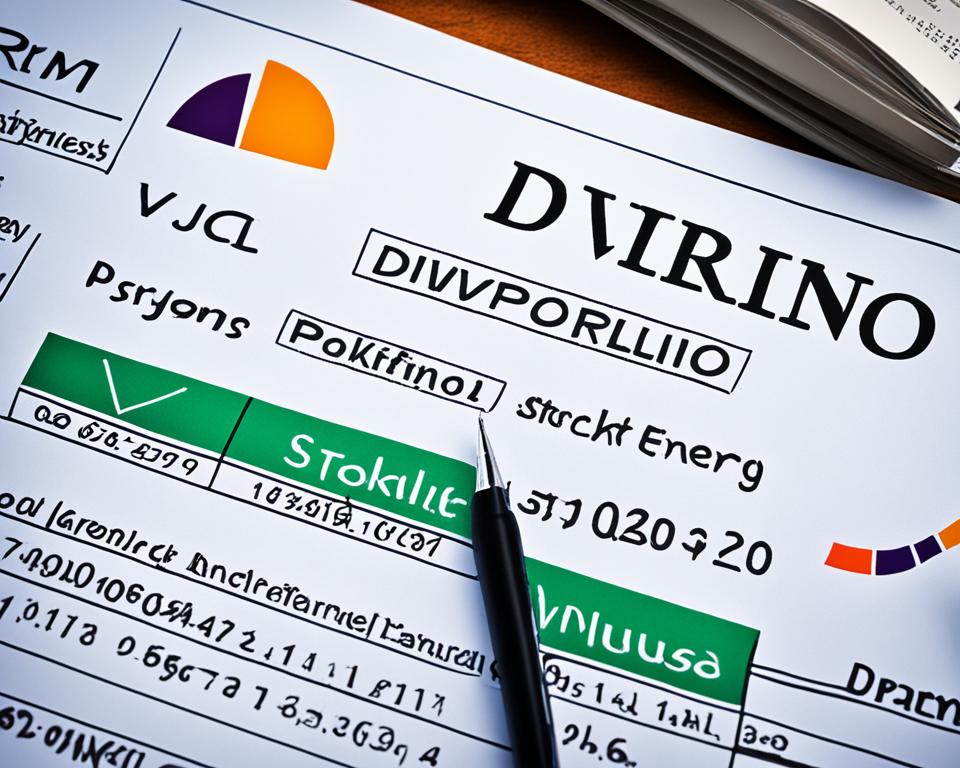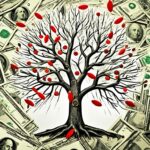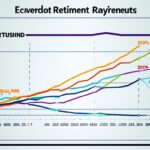For investors aiming to build a stable income stream, dividend sustainability represents a cornerstone concept that warrants thorough investigation before adding stocks to their portfolio. The ability to effectively assess dividends lies in understanding crucial financial indicators, notably the dividend yield and payout ratio. These metrics are not merely numbers on a financial statement—they are the crystallized reflections of a company’s past performance and future potential through the lens of shareholder returns. In the intricate dance of investment decision-making, mastery of these concepts is foundational.
Dividends serve as a tangible reward to shareholders for their investment, but the reliability of these payouts is subject to multifaceted economic factors. Investors must dissect data such as a company’s cash flow, debt obligations, and overall strategic planning to ascertain the likelihood of continual dividend returns. This investor’s guide aims to demystify the terms and provide a road map for evaluating the strength and stamina of dividend-bearing stocks.
Key Takeaways
- A robust dividend yield can be a siren call to income-minded investors, but it must be vetted for enduring value.
- The payout ratio is an essential temperature check on a company’s dividend health, indicating the percentage of earnings earmarked for shareholder payouts.
- An ideal dividend sustainability profile features a payout ratio that leaves room for future dividend growth and business investment.
- A thorough evaluation includes a comparison of dividend yield and payout ratios to those of similar companies within the same industry.
- To truly assess dividends, investors should blend diverse financial ratios with an understanding of market conditions and corporate strategies.
Understanding the Fundamentals of Dividend Yields
The concept of dividend yield is fundamental to the toolkit of savvy investors, especially those who focus on income-generating stocks. Often stated in percentage terms, this yield serves as a snapshot of the potential returns a shareholder might garner in relation to the share price of dividend-distributing companies. Particularly eye-catching are high dividend yield stocks that eclipse traditional financial benchmarks, promising more immediate returns than some bonds or savings accounts.
Definition and Importance of Dividend Yield
At its core, the dividend yield definition encapsulates the quotient of a company’s annual dividend payments and its current share price. This ratio, an integral part of dividend yield calculation, enables investors to compare the relative attractiveness of various dividend-paying stocks. Yields exceeding the performance of reliable financial benchmarks, such as the 0.91% U.S. Treasury yield as of June 5, 2020, are deemed particularly desirable.
How to Calculate Dividend Yield
Arriving at a dividend yield involves a straightforward yet imperative dividend yield formula. To calculate it, an investor divides the annual dividends per share (DPS) a company pays out by its current price per share (PPS). If you prefer visual learning or reminders, consider this simple representation:
| Annual Dividends per Share (DPS) | Current Price per Share (PPS) | Dividend Yield (%) |
|---|---|---|
| $4 | $100 | 4% |
| $2 | $50 | 4% |
| $1 | $20 | 5% |
The dividend yield for a stock can be fluid, changing as the price of the stock fluctuates. Thus, it is critical for investors to monitor their portfolios for shifts that may affect their potential dividend returns.
Comparison to Other Financial Metrics
Comparing dividend yields to other financial benchmarks illuminates the yield’s relative strength or weakness. For instance, a stock’s dividend yield that outperforms the current U.S. Treasury yield suggests an opportunity for higher income. However, investors should always consider the risks involved and examine dividend stability alongside other key financial metrics like earnings growth, free cash flow, and the company’s historical dividend patterns.
By thoroughly understanding the dividend yield’s role within the broader spectrum of financial analysis, investors are better equipped to select stocks that align with their strategies for income and growth.
Key Indicators of Dividend Stability
For those with their sights set on the long-term prize, dividend stability is a crucial beacon in navigating the equity markets. Prudent investors realize that stability in dividends doesn’t just reflect a company’s current generosity but is a trustworthy predictor of its financial well-being and strategic soundness. The long-term sustainability of dividend payouts is not just a factor of current company earnings; it is deeply intertwined with the firm’s capital structure and profound dealings with key financial metrics.
The bedrock of dividend reliability lies within the narratives of financial ratios such as the dividend payout ratio, dividend coverage ratio, and free cash flow to equity (FCFE). These measures are not just numbers on a spreadsheet; they are the financial fingerprints of a company’s past payouts and a crystal ball into its ability to maintain those payments moving forward.
A closer look at these ratios reveals a story of discipline and foresight. A sensible capital structure, retained earnings, and a reasonable sum of debt showcase not only prudence but also mirror the confidence a company has in its own growth trajectory. A business that practices moderation in borrowing exhibits resilience—a quality much admired by those who appreciate steady and sustainable returns.
When we peel back the layers to ponder on the dividend payout ratio, we find insight into the percentage of net income funneled back to investors in the form of dividends. The general consensus leans towards favoring a lower payout ratio, as this may indicate a company’s ability to grow its dividends over time without sacrificing its need to reinvest back into the business.
The dividend coverage ratio, on the other hand, helps investors to understand how comfortably a company can cover its promised dividends. Think of it as a buffer—the higher the ratio, the safer the declared dividend. And then there’s the role of free cash flow to equity (FCFE), which tells us the clear amount of cash available to equity shareholders after all expenses, reinvestments, and debts are paid. It’s essentially the pool from which dividends can be drawn, thus illuminating a company’s capability to reward its shareholders whilst maintaining its economic engine.
But let’s not deal in abstractions alone. Engage with the details of these ratios below and see for yourself how different companies might stack up when it comes to dividend stability:
| Company | Dividend Payout Ratio | Dividend Coverage Ratio | Free Cash Flow to Equity |
|---|---|---|---|
| Procter & Gamble | 60% | 2.5 | $10B |
| Johnson & Johnson | 70% | 1.8 | $15B |
| Coca-Cola | 80% | 1.2 | $8B |
Amid the rigors of the financial landscape, dividend stability stands as the North Star for those seeking solace in the form of regular income. May this guide serve to lead you to the companies most capable of providing that promise of stability. As with any journey through the wilderness of investing, to assess dividends is to prepare, to anticipate, and to pace oneself for the long road ahead.
Analyzing the Dividend Payout Ratio
To calculate dividend payout, a stakeholder must delve into a company’s financials, focusing particularly on its ability to reward shareholders with dividends. Grasping the dividend payout ratio, a key measure of this capability, can provide insights into the sustainability of a company’s dividend payments. This ratio represents a snapshot of earnings allocated to pay dividends, and it plays a critical role in forecasting the prospects of future dividend increments or their potential risk.
Investors, therefore, scrutinise the dividend payout ratio not only as a measure of present distribution but as a hint of possible financial futures. The lower this ratio, the more room a company has to grow its dividend payouts and, often, its business. Conversely, a high ratio might signal upcoming challenges in upholding dividend payments, especially if sustaining such payouts puts a strain on company reserves over time.
But dividends don’t exist in a vacuum. To provide meaningful insights, a company’s payout statistics should be stacked against industry dividend standards. Industry norms provide context, allowing investors to discern whether a high payment rate is a warning or merely part of industry practice.
Calculating the Dividend Payout Ratio
To calculate the dividend payout ratio, an investor divides the annual dividends per share by the earnings per share. Another approach is to take the total dividends paid by a company and divide it by that company’s net income. The result produces a percentage reflecting the portion of income directed towards shareholders.
Understanding the Implication of High Payout Ratios
Discerning the high payout ratio implications is essential for any investor with an eye on dividends. A high dividend payout ratio can suggest that a company is returning the majority of its earnings to shareholders as dividends, potentially leaving less capital for growth and operational flexibility. This kind of financial tightrope walk may not be sustainable in the longer term, particularly in challenging economic conditions.
Consistently high payout ratios could flag risks such as the inability to maintain dividend payments in the event of a downturn or unexpected financial obligations. As such, while a generous payout can be alluring, it can also herald a need for caution and further, deeper analysis.
Industry Standards for Payout Ratios
The industry standards for payout ratios vary greatly and shed light on a company’s dividend policy within its competitive landscape. In industries with stable cash flows and minimal growth opportunities, like utilities or consumer goods, high dividend payouts are common and sustainable. Conversely, in high-growth or capital-intensive sectors, such as technology or biotech, lower ratios are normal as funds are frequently reinvested in innovation and expansion.
When assessing the payout ratio, it is crucial for an investor to compare their findings not only against the market at large but within the confines of the company’s sector. This kind of specific comparison can reveal much more about a company’s dividend disposition than broader market contrasts.
Interpreting Dividend Yield for Investment Decisions
When it comes to investment decision-making, the allure of high dividend yields can be compelling. However, astute investors know that interpreting dividend yield requires a deeper dive into the numbers to ensure the selections made are indeed sound. It’s not just about the immediate gratification of current returns but also the strategic contemplation of dividend yield vs growth. This nuanced approach balances the thirst for instant income with the prudent pursuit of long-term growth.
Accurately interpreting dividend yield includes an examination of a company’s dividend history relative to its share price adjustments. Investors must be mindful that a high dividend yield, while potentially lucrative, can also signal underlying financial challenges within a company—challenges that could compromise the sustainability of returns.
An insightful practice in investment decision-making is to evaluate the dividend yield in the context of the company’s growth phase. Growth-oriented companies, often in their nascent stages, tend to reinvest profits back into the company rather than distribute them as dividends, thus attracting investors with the promise of capital appreciation rather than immediate yield.
A discerning investor recognizes the harmony that exists between dividend yield and a company’s economic vigor; they seek yields that are not just high in isolation, but high in conjunction with healthy financials and viable expansion prospects.
By juxtaposing the current yield with historical trends, investors interpret the relative consistency and reliability of a company’s payout practices. Such thorough analysis leads to more insightful investment decision-making, illuminating the trajectory between dividend yield and growth strategies. Observing how a company’s dividend yield maneuvers through economic cycles can provide investors with greater confidence in their investment choices.
- Review the historical stability and trends of a company’s dividend yield.
- Assess the company’s financial health through earnings reports and future earnings prospects.
- Consider industry-specific benchmarks for dividend yields; what is high in one industry may be average in another.
Ultimately, the art of interpreting dividend yield serves as an essential chapter in the narrative of investment success. This task demands attention to detail, a strategic mindset, and an appreciation for both short-term returns and long-term value creation.
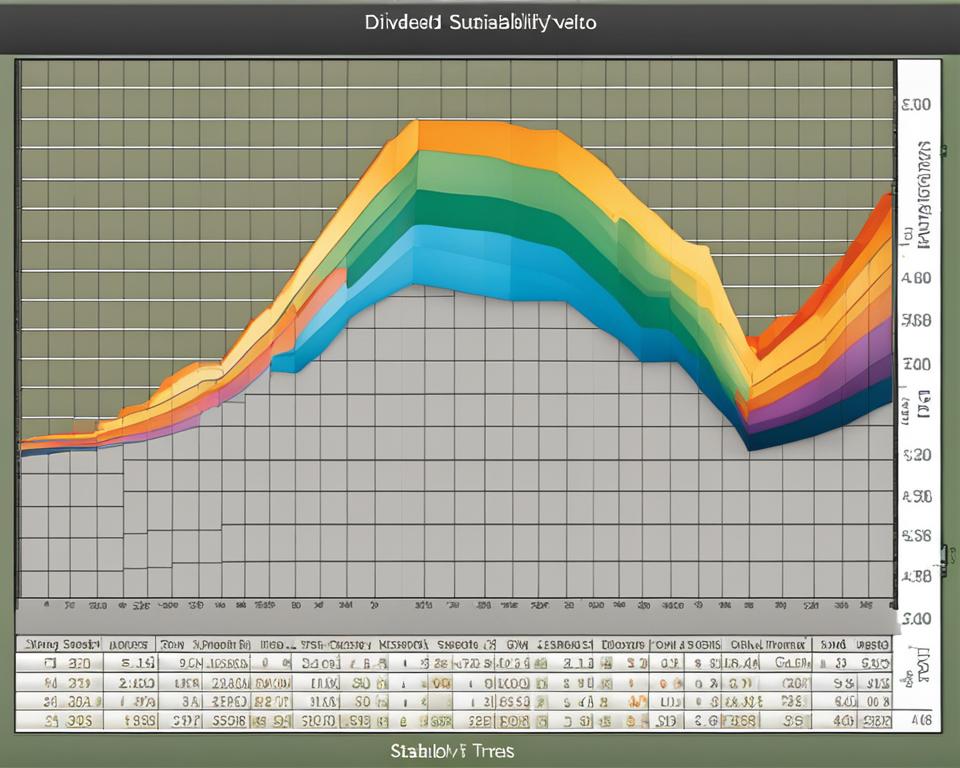
Free Cash Flow’s Role in Dividend Issuance
In the quest to determine the robustness of dividends, savvy investors pay close attention to free cash flow to equity (FCFE). This financial metric is paramount when gauging dividend safety, as it quantifies the cash a company can potentially distribute to shareholders after encompassing all expenses, debts, and reinvestments. An adequate understanding and cash flow analysis, encompassing FCFE calculation, can highlight the true capacity of a business to sustainably reward its shareholders.
Before we explore how FCFE is calculated and its implications for dividend safety, let’s recognize the foundational role this metric plays. When a company has a healthy FCFE, it’s indicative of sufficient cash reserves that can cushion against operational and market volatilities — leading to a reliable dividend payout.
Calculating Free Cash Flow to Equity (FCFE)
The calculation of FCFE involves taking the net income and adjusting it for net capital expenditures, debt repayment, and changes in working capital. The aim is to estimate the cash remaining for shareholders after the company has met all its financial obligations. Here’s the formula for clarity:
FCFE = Net Income – Net Capital Expenditures – Net Debt Repayment + Change in Working Capital
Where capital expenditures refer to the investments a company makes in long-term assets, net debt repayment is the difference between debts repaid and new debts incurred during the period, and working capital alterations account for the company’s ability to manage its short-term obligations with its short-term assets.
Assessing Dividend Safety through FCFE
When it comes to dividend safety, FCFE acts as a litmus test, revealing whether a company’s dividend is supported by the actual cash generated from its business activities. High FCFE signifies that a company is more likely able to uphold or increase its dividends over time. Conversely, minimal or negative FCFE could hint at future dividend cuts, as the firm might not generate enough cash to support its distribution policy.
Therefore, a thorough cash flow analysis incorporating the FCFE gives investors insights into a business’s capability to sustain its dividends. It’s the linchpin for investors seeking reassurance that a company is not only growing but also returning real value to its shareholders.
Debt Levels and Dividend Sustainability
The symbiotic relationship between a company’s debt levels and its dividend sustainability cannot be overstated. High company leverage manifests in several ways, including restriction of free cash flow, thus impacting an organization’s aptitude for consistent dividend distribution. In essence, a firm’s capacity to maintain and potentially increase dividend payments heavily relies on its financial leveraging decisions. Investors, hence, need to dig deeper into both the absolute figures and the observed variations in debt levels to accurately gauge the future feasibility of dividend sustainability.
An investor considering the sustainability of dividends must start by scrutinizing the firm’s debt-to-equity ratio, which provides a snapshot of the company leverage against its shareholders’ equity. This ratio is paramount—it paints a vivid picture of the balance between debt and equity financing, which consequently impacts the available earnings for dividend payments. But awareness requires more than a one-off glance; tracking the trajectory of this ratio over time affords investors vital clues about the company’s strategic financial management and its potential impact on future dividends.
Concerns mount when a company’s debt levels swell, signaling potential red flags for dividend investors. Elevated debt can not only strangle cash flows but also dictate a firm’s priorities—often favoring debt servicing over shareholder dividends. This prioritization means high debt can not only diminish the amount available for dividends but also increase the cost of capital, which has a domino effect on a company’s financial health and, by extension, its dividend sustainability.
To clarify the influence of debt on dividend payouts, consider this illustration.
| Company | Debt-to-Equity Ratio | Interest Coverage Ratio | Dividend Payout Ratio |
|---|---|---|---|
| Company A | 0.8 | 5 | 40% |
| Company B | 1.5 | 3 | 60% |
| Company C | 2.5 | 2 | 80% |
In the table above, one can distinguish the direct correlation between increasing debt levels and higher dividend payout ratios. Company C, with a higher debt-to-equity ratio, may find itself in a precarious position, as a significant amount of income is being used to service debts, thus reducing the amount available for dividends. A critical strategy for investors is to balance the pursuit of healthy yields against the backdrop of a company’s leverage and fiscal sustainability.
Investors keen on dividend longevity should be especially vigilant of companies whose debt levels are climbing without a proportional surge in earnings or cash flows. Unchecked leverage can imperil dividend distributions and expose investors to higher risks during market downturns or economic stresses.
Dividend sustainability consequently becomes a matter more intricate than surface yields and requires a thoughtful analysis of how company leverage may influence future payouts. Recognizing this, investors are urged to conjoin their yield expectations with deep financial scrutiny — particularly paying heed to debt covenants that may foretell a tightening of dividend policies in an effort to manage existing debts.
Through this comprehensive approach to evaluating debt’s impact on dividends, investors can more reliably predict the viability and longevity of a company’s dividend distribution strategy and make more informed decisions that align with their financial goals.
Critical Assessment of Net Debt to EBITDA Ratios
In the landscape of corporate finance, leverage ratios such as the Net Debt to EBITDA ratio stand out as vital barometers for assessing a company’s fiscal health and its ability to sustain dividend payments. This particular ratio provides an intuitive understanding of a company’s debt relative to its earnings, shining light on how likely it is to meet its liabilities—and reward shareholders.
Understanding Net Debt to EBITDA
The Net Debt to EBITDA ratio is a potent tool in an investor’s analytical arsenal. It offers a clear vantage point from which to examine a corporation’s leverage. Specifically, it juxtaposes a firm’s total debt, after subtracting cash and cash equivalents, against its earnings before interest, taxes, depreciation, and amortization (EBITDA). A low ratio is often an indicator of a robust financial footing, suggesting a strong capability to shoulder debt without jeopardizing operations or dividend payment implications.
Implications of a Rising Net Debt to EBITDA Ratio
While a low Net Debt to EBITDA ratio can be a harbinger of fiscal prudence, a rising ratio carries warnings of potential financial stress. An uptick in this ratio over time can flag concerns that the company may struggle to service its debt, which, in turn, could compromise its ability to uphold or increase dividend distributions. Such shifts might cue investors to be circumspect regarding a firm’s long-term dividend prospects.
Take a pragmatic view of this measure through the lens of specific industries and prosperous contenders:
| Company | Industry | Net Debt to EBITDA Ratio | Dividend Payment Trend |
|---|---|---|---|
| Apple Inc. | Technology | 1.0 | Increasing |
| General Electric | Industrial | 2.7 | Stable |
| AT&T Inc. | Telecommunications | 2.8 | Decreasing |
Corporations like Apple Inc. showcase a balanced approach to leverage, with manageable Net Debt to EBITDA ratios accompanying a trend of increasing dividends, illustrating well-maintained fiscal health. Contrastingly, a company exhibiting a high and climbing ratio with diminishing dividends, as seen with AT&T Inc., underscores the pressing need for investors to monitor these ratios to foretell and navigate the vicissitudes of dividend payouts.
In conclusion, the Net Debt to EBITDA ratio should be scrutinized alongside other leverage ratios for a comprehensive view of a company’s financial trajectory and to anticipate the stability of future dividend payments. Investors would do well to integrate these insights with broader economic trends, the strategic positioning of the company, and its historical commitment to shareholder returns.
The Importance of Dividend Coverage Ratios
The dividend coverage ratio often emerges as a definitive financial health indicator within the complex domain of investing. Representing the number of times a company can pay dividends with its net income, this ratio is a safety net that investors rely on to gauge dividend sustainability. A respectable dividend coverage ratio cushions a company’s future, projecting confidence and reinforcing its commitment to shareholders.
To distill the essence of this metric, one must consider the earnings per share (EPS) and the dividends per share (DPS)—two numbers that encapsulate the strength of a company’s profits and its returns to shareholders. The equation is straightforward yet significant, with annual EPS divided by annual DPS providing a clear view of dividend security. A higher ratio implies that a company can comfortably cover its dividends, indicative of a robust financial standing.
Let’s explore this in greater depth through the lens of real-world examples:
| Company | EPS | DPS | Dividend Coverage Ratio |
|---|---|---|---|
| Intel Corporation | $5.00 | $1.39 | 3.60 |
| Pfizer Inc. | $2.22 | $1.56 | 1.42 |
| 3M Company | $10.12 | $5.88 | 1.72 |
In the above table, consider how an elevated dividend coverage ratio, like that of Intel Corporation, could suggest not only a commendable history of payments but also a promising trajectory for continuous, and potentially increasing, dividends to its shareholders.
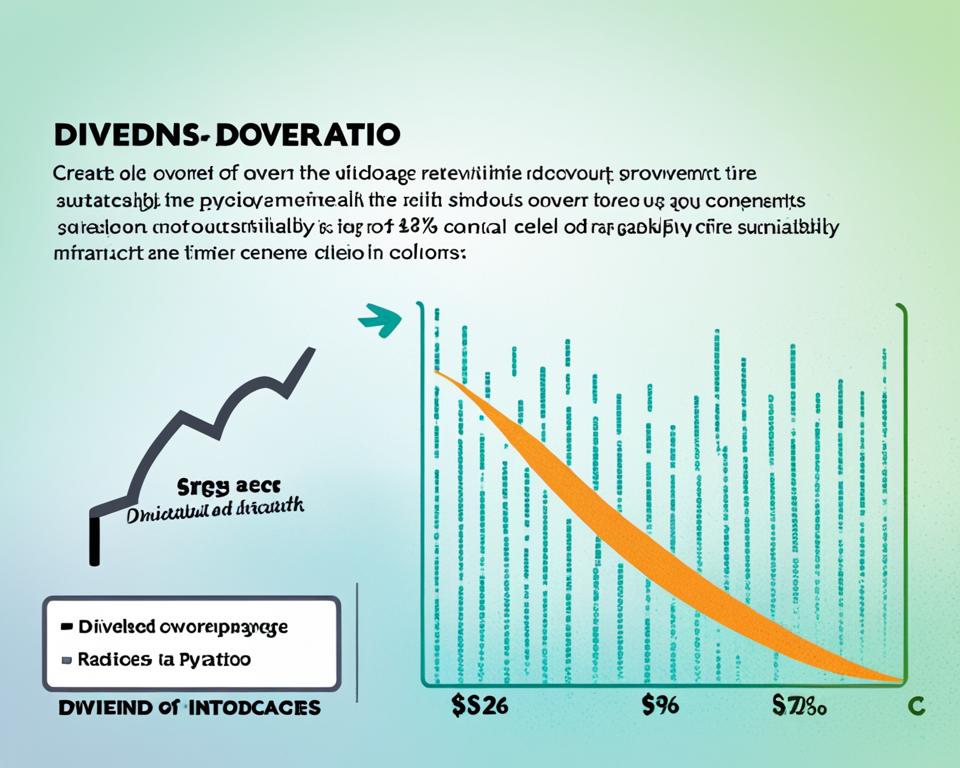
Analyzing a company’s dividend payment history through its coverage ratio enables investors to sift through superficial attractiveness and uncover the stability of potential income streams. Hence, dividend coverage stands as a grand pillar upon which investor confidence can securely rest. Whether one is a burgeoning investor or a seasoned financier, the significance of a well-founded dividend coverage ratio cannot be superseded, and its analysis becomes a staple practice in the pursuit of dividend-rich equities.
Conclusively, the dividend coverage ratio is more than a mere numerical figure; it is a beacon for those who meticulously assess the financial fortitude of corporations. It seamlessly fuses the insights provided by EPS and DPS, contributing to a holistic view of a company’s fiscal resilience, serving as an indispensable compass in the boundless ocean of investment opportunities.
Evaluating a Company’s Dividend History
Analyzing a company’s dividend history can illuminate the path towards understanding its potential for future performance. This exploration into the past provides insights into both the firm’s financial fortitude and its dedication to delivering shareholder value. Through a study of dividend payment trends, investors can identify patterns that are predictive of financial stability and growth capacity. Recognizing these dividend trends is akin to peering through a financial lens that magnifies a company’s commitment to its shareholders’ enduring prosperity.
Assessing the trajectory of past dividends unfolds a narrative that speaks volumes about management’s strategies and the organization’s ability to navigate through turbulent markets. As we distill the history into actionable intelligence, we can begin to craft a more informed picture of prospective dividends and overall financial health.
Trends in Dividend Payments and Growth
The evolution of a company’s dividends over time is a crucial metric for investors. It is not simply the act of delivering returns that appeals to the discerning investor, but the quality and growth of these returns. Dividend payment trends that exhibit gradual and consistent growth signal a company’s healthy cash flow and a business model that’s both profitable and sustainably managed.
- Steadiness in dividend increments suggests sound financial management.
- A sudden surge or drop in dividends may warrant a deeper financial analysis to understand the underlying causes.
- Businesses that regularly adjust their dividends upward are often seen as confident in their future revenues.
What Past Dividends Reveal About Future Performance
While historical performance is not a guaranteed predictor of future results, past dividends often hold clues to the future performance indicators of an enterprise. A strong record of dividend payments can be indicative of solid corporate governance and a business model that’s resilient enough to withstand industry shake-ups. Furthermore, this consistency supports the potential for ongoing returns, making such stocks a potentially attractive option for income-focused investors.
- Analyze the historical continuity and size of dividend payments as indicators of future reliability.
- Consider the company’s operational efficiency and market position as they contribute to sustain its dividend policy.
- Scrutinize the balance sheet and cash flow statements to confirm the support for continual dividend distribution.
Ultimately, a comprehensive examination of a company’s dividend history serves as a vital step in forecasting its future dividends. Informed investors will use a company’s dividend chronicle as a significant part of their strategic approach to stock selection, looking for not only a history of payments but also the promise of future profitability and growth.
Dividend Yield Versus Dividend Growth
Deciphering between dividend yield vs dividend growth is a pivotal step in aligning investment choices with investor priorities and long-term financial objectives. High-yield stocks might appear as an enticing option for immediate income—a beacon for those seeking quick returns. Conversely, a trajectory of rising dividends often signals a company’s enduring commitment to reinvestment and its prospects for growth strategies.
Yet, contriving an investment strategy that marries the two concepts is to balance the allure of immediate cash flow with the potential for value appreciation. Such a dichotomy prompts investors to scrutinize whether a substantial yield is a mark of ongoing strength or an unsustainable offering that could evaporate under the harsh lens of economic change.
Reflecting upon dividend growth, savvy investors decipher intricacies beyond mere payout increases. Scrutiny is directed at a company’s reinvestment strategy, the sustainability of its earnings growth, and the operational acumen embedded within. Does the company wield a cast-iron business model that permits both lucrative payouts and robust growth?
Moving beyond the surface yields, investors employ a diversity of metrics to ascertain which dividend approach—yield or growth—alights with their financial blueprint. Let us consider a hypothetical comparative analysis:
| Investment Approach | Dividend Yield Focus | Dividend Growth Focus |
|---|---|---|
| Initial Return Potential | High | Variable |
| Long-term Growth Prospect | Lower | Higher |
| Reinvestment in Business | Less Likely | More Likely |
| Investor Profile Suitability | Income-focused | Growth-oriented |
Embarking on the dividend pathway, investors must weigh their portfolios’ current needs against future aspirations. Is the priority to generate steady, short-term income, perhaps in a retirement portfolio? Or does the investor lean towards capital appreciation and the long-range expansion of assets?
Ultimately, the measured comparison of dividend yield vs dividend growth is more art than science, blending astute analysis with personal investment philosophy. Forging this alliance opens doors to bespoke portfolios that not only address present financial necessities but also pave the way for future prosperity.
- Examine both dividend yield and growth against company fundamentals and industry standards.
- Align dividend investment strategies with personal financial goals and risk tolerance.
- Be vigilant of high yields that may not be sustainable in the changing economic landscape.
- Consider the compounding effect of reinvesting dividends from growth-focused companies.
As investors navigate the waters of income versus appreciation, the astute integration of both yield and growth into their fiscal fabric remains a hallmark of strategic investing. In this equilibrium, lies the potential for portfolio resilience amid the ebb and flow of market dynamics.
Prospects of High Dividend Yield Stocks
In the realm of investment strategy, high dividend yield stocks can provide an enticing avenue for those seeking substantial income from their equity holdings. These stocks typically stand out in the market, offering yields that can surpass the returns of other traditional investments such as Treasury bonds. The attraction to high dividend yields lies not only in the potential for a steady income stream but also in the implication of a company’s confidence in sharing profits generously with its shareholders.
Advantages of Investing in High Dividend Yield Stocks
Investing in high dividend yield stocks carries several investment advantages that can be particularly appealing. With these stocks, investors have the opportunity to receive regular, substantial payouts, which can be particularly beneficial for those in need of a consistent income, such as retirees. Additionally, should these dividends emanate from companies with stable earnings and historical consistency in payout increments, they may point to an enduring shareholder value.
Another advantage is the potential for these stocks to act as a hedge against market volatility. During tumultuous market periods, dividends can offer a buffer, providing returns even if the stock price does not appreciate significantly. It’s an approach that champions the steady accumulation of wealth, without necessitating the sale of assets to realize gains.
Potential Risks Associated with High Dividend Yields
High yields, however, are not without their pitfalls, which can introduce unique dividend yield risks into an investment portfolio. A yield that appears high relative to the market average may be symptomatic of underlying issues within the issuing company. For instance, if dividend yields are not supported by robust and sustainable earnings, there stands a risk that dividends may be reduced or scrapped in the future, especially if the company faces cash flow problems or increased debt levels.
Investors must also weigh the possibility that a high yield is indicative of a stock price in decline, potentially signaling deteriorating company fundamentals or lowered investor confidence. While a high dividend payout may initially seem attractive, a fundamental shift in the company’s financial structure or market position could portend trouble down the line, necessitating a cautious evaluation of its sustainability.
Savvy investors, therefore, conduct a comprehensive analysis of a company’s financial health, considering factors such as free cash flow, earnings stability, and the consistency of the dividend policy over time. This allows for an understanding of whether current high dividend yield stocks are a product of strategic financial management or a potentially unsustainable financial position.
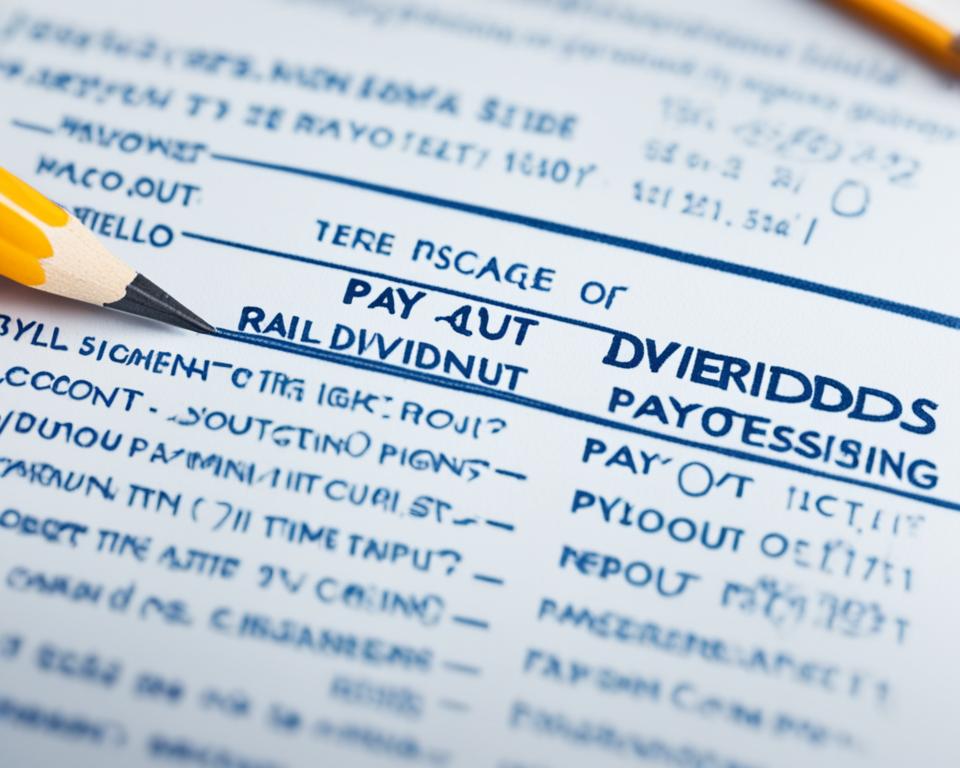
Choosing Between Dividend Yield ETFs and Individual Stocks
An integral part of formulating an effective investment strategy is deciding whether to invest in dividend yield ETFs or individual dividend stocks. This decision hinges on several factors, including diversification, management fees, and the investor’s desire for control over their portfolio. Each option comes with its distinct set of advantages and implications for yield potential and risk exposure.
Dividend yield ETFs offer an appealing proposition for investors looking for diversification. Structured to track a specific index of dividend-paying stocks, ETFs conveniently provide exposure to a broad array of companies. This minimizes the idiosyncratic risk associated with individual stocks and can be a prudent choice for those less inclined to perform extensive company-specific research.
Conversely, selecting individual dividend stocks affords investors the opportunity to tailor their portfolio to exacting specifications, potentially targeting firms with the ability to provide higher dividend payouts or stronger growth prospects. However, success in this arena necessitates a more hands-on approach and a deeper dive into financial analyses to ensure sustainable dividend returns.
Understanding the cost implications of each choice is also vital. ETFs carry management fees, which can eat into the dividend returns, although these are typically lower than actively managed funds. Selecting individual stocks can circumvent such fees but often requires a more significant time investment in portfolio management and research.
| Investment Type | Diversification Level | Management Fees | Research Requirement | Investor Control |
|---|---|---|---|---|
| Dividend Yield ETFs | High | Yes (generally low) | Low | Low |
| Individual Dividend Stocks | Varies (Based on selection) | No | High | High |
In seeking to balance the tradeoffs between dividend yield ETFs and individual dividend stocks, investors are advised to evaluate their own risk tolerance, investment objectives, and available time to manage their holdings. A well-considered approach might involve leveraging both options to attain an optimally diversified, cost-effective portfolio that aligns with one’s desired level of involvement.
Whether opting for the broad-based approach of ETFs or the focused selection of individual stocks, the key to success lies in aligning investment choices with personal financial goals and appetite for risk.
To sum up, the choices between dividend yield ETFs and individual dividend stocks are not mutually exclusive. A blended investment strategy might provide a harmonious balance, offering both the convenience of ETFs and the targeted potential of individual stocks.
Top Dividend Yield Companies to Watch
As we explore the landscape of consistent shareholder returns, certain top dividend yield companies stand out not only for their impressive yields but also for their strategic methodologies that promise maintaining dividend excellence. These organizations have cemented themselves as market leaders due to their adept management of payout ratios and unwavering commitment to shareholder value.
Market Leaders and Their Dividend Strategies
The guiding force behind the success of these market leaders lies in their astute market leader strategies. These corporations underscore a commitment to stable and reliable earnings, which acts as a bedrock for their dividend policies. It is this focus on sustainability and growth, paired with prudent financial practices, that turns a company into a beacon for investors seeking dividend reliability.
How Top Companies Maintain Dividend Excellence
Delving into maintaining dividend excellence, we find a series of shared traits amongst these financial stalwarts. Mastery of capital allocation allows them to not only reward shareholders but also reinvest in their core business operations—a balance that perpetuates growth. Furthermore, these companies demonstrate a discernible pattern of profitability and a historical resilience to economic cycles, providing investors with a semblance of certainty in an otherwise tumultuous market.
Exemplar companies in this realm exhibit strong fiscal health—a testament to their acumen in navigating market challenges while still prioritizing shareholder returns. Their commitment to dividend excellence remains unwavering even as they evolve and adapt to the changing contours of the global economy. It is this unwavering dedication that makes these leaders worthy of attention from those looking to bolster their portfolios with promising dividend prospects.
Special Considerations for Using Dividend Ratios
When using dividend ratios as part of investment evaluations, investors must traverse beyond the surface of numerical values to uncover a more vibrant and substantial financial story. A company’s dividend ratios, while reflective of its present financial status, may not encapsulate the comprehensive health of the business or its long-term prospects.
To make informed financial decisions, astute investors consider a tapestry of elements where dividend ratios serve as a single, albeit critical, thread. Factors such as the industry’s financial climate, economic cycles, and a company’s operative efficiency are weighed with equal gravity alongside these ratios to assess the sustainability of dividends.
For a clearer view of the financial landscape, investors often compare dividend ratios against the backdrop of wider market trends. Industry-specific benchmarks and norms provide context and enrich the investor’s knowledge base, setting the stage for insightful analysis and comparison.
- Analyze the company’s scalability and earnings potential to predict dividend endurance.
- Look at a company’s growth trajectory, weighing historic performance against future projections.
- Evaluate dividend ratios in the light of industry dynamics and market conditions.
- Consider the business model’s robustness to sustain and grow dividend payments over time.
- Assess management’s strategic decisions and their implications on future dividend policies.
Investors seek assurance that their portfolio choices are buttressed by reliable and transparent financial practices. As such, dividend ratios form the foundation for such certainty, while the in-depth examination of enterprise fundamentals and industry-specific factors construct the remainder of the analytical edifice.
Corporate responsibility and governance also play an intangible yet potent role in the decision-making process, providing evidence of a company’s commitment to maintaining its dividend payouts through thick and thin. Henceforth, dividend ratios are not a standalone beacon but part of an interconnected financial lighthouse, guiding investors safely towards their goals.
For those deliberating the stability and growth of dividend-yielding investments, consider this distilled wisdom: delve deep into the mosaic of financial indicators and stand ready to adjust sails as new market insights emerge.
Conclusion
The journey of investor guidance toward successful income generation through dividends reaches a pivotal point in the comprehensive dividend analysis. A crucial takeaway for investors is the necessity of embracing a meticulous examination of financial health indicators like the dividend yield and payout ratios. Such is the path to a robust dividend yield assessment, forever intertwined with an understanding of industry benchmarks, historical performances, and economic currents. Being astute in this regard ensures that investments made today are poised to bear the fruits of sustainable dividends tomorrow.
Informed decisions are the bedrock upon which stable, long-term returns are built. It is this strategic selection, underpinned by thoughtful analysis, which distinguishes the keen investor. By delving deeply into the fabric of a company’s financial narrative, while navigating through broader industry spectrums, the investor’s acumen is both honed and rewarded. The complexities of the market demand nothing less than this holistic perspective – a marriage of nuanced scrutiny and strategic foresight.
In conclusion, the sagacious investor walks this path with deliberation and acuity, leveraging the wealth of available data to chart a course through the ever-shifting landscapes of the market. It is such methodical and comprehensive approaches to dividend yield assessment, buttressed by well-founded investor guidance, that open the doors to financial prosperity and the assurance of one’s investment journey.
FAQ
What is dividend sustainability and how can it be assessed?
Dividend sustainability refers to a company’s capacity to continue paying dividends at the current or an increasing rate without financial strain. Investors can assess this by examining the dividend yield, payout ratio, company earnings, and capital structure to understand the company’s financial well-being and the likelihood of maintaining dividends.
How does the dividend yield benefit investors?
The dividend yield gives investors an indication of the return they might expect in relation to a company’s share price. A higher dividend yield can be attractive, but it’s essential to consider the sustainability and the reason behind the yield being above average – high yields can sometimes indicate potential risks.
What is the formula for calculating dividend yield?
Dividend yield is calculated by dividing the annual dividends per share by the price per share. This result is often represented as a percentage, giving investors a quick way to compare the income-producing potential relative to the share price of different companies.
Why should dividend yield be compared to other financial metrics?
Comparing dividend yield to other financial benchmarks, like the U.S. Treasury yield, helps investors gain perspective on the attractiveness of a stock’s return relative to risk-free government-issued securities and other investment opportunities.
What role does dividend stability play in investment decisions?
Dividend stability indicates the likelihood of a company continuing to pay dividends consistently. Stable or increasing dividends over time reflect company strength and financial flexibility. Investors regard dividend stability as a sign of a reliable income stream from their investments.
How do you calculate the dividend payout ratio?
The dividend payout ratio is calculated by dividing the total dividends paid by the net income or the annual dividends per share by earnings per share. This metric helps investors understand what proportion of earnings a company is returning to shareholders as dividends.
What are the implications of a high dividend payout ratio?
A high dividend payout ratio could signal that a company is returning most of its earnings to shareholders, leaving less capital for future growth or debt repayment. It can sometimes indicate a riskier investment, as it may not be sustainable in the long term.
Why should payout ratios be compared within the same industry?
Because industries have different capital intensity, growth prospects, and earnings stability, it’s meaningful to compare payout ratios among similar companies in the same industry. This provides context regarding what a typical or sustainable payout ratio might look like in that sector.
What should investors consider in addition to dividend yield for investment decision-making?
Besides dividend yield, investors should consider the overall financial health of the company, its dividend payout ratio, earnings stability, growth prospects, and the company’s ability to raise dividends in the future (dividend growth).
How does free cash flow to equity (FCFE) affect a company’s ability to issue dividends?
FCFE represents the cash available for distribution to shareholders after accounting for expenses, working capital, capital expenditures and debt repayments. A positive and stable FCFE indicates a company has sufficient resources to sustain and potentially grow its dividends.
What is the significance of a company’s debt levels when considering dividend sustainability?
A company with high debt levels may face constraints on its cash flow, which can limit its ability to maintain or increase dividend payments. Investors should be wary of high debt as it can lead to reductions in dividends during financial or economic stress.
How does the Net Debt to EBITDA ratio relate to dividend payments?
The Net Debt to EBITDA ratio measures a company’s ability to pay off its debt with its earnings before interest, taxes, depreciation, and amortization. A lower ratio suggests a healthier financial position, potentially leading to consistent or growing dividends, whereas a higher ratio can indicate financial stress and potential dividend cuts.
How do you interpret the dividend coverage ratio?
The dividend coverage ratio is a measure of a company’s ability to pay its dividends from its net income. It’s calculated by dividing earnings per share (EPS) by dividends per share (DPS). A higher ratio suggests more comfortable coverage of dividend payments, whereas a lower ratio raises concerns about a company’s capability to maintain dividends.
Why is examining a company’s dividend history important?
A company’s dividend history can reveal its commitment to shareholder returns and indicate financial health, stability, and a potential for continued payouts. Consistent and growing historical dividends are often seen as positive signals for future performance.
Should investors opt for dividend yield or dividend growth?
The choice between dividend yield and dividend growth depends on individual investors’ goals. High-yield stocks may suit those seeking immediate income, whereas dividend growth stocks can be preferable for long-term wealth appreciation and the indication of a company’s potential reinvestment into its growth.
What are the benefits and risks of investing in high dividend yield stocks?
High dividend yield stocks offer the benefit of immediate income, possibly above average. However, they can also signal a company’s financial distress or a potential dividend cut if the high yield is unsustainable, making it crucial to evaluate the reasons behind the high yield.
How do dividend yield ETFs compare to individual dividend stocks?
Dividend yield ETFs provide a diversified portfolio that may reduce risk and come with management fees, while individual stocks allow for specific targeting but require more intensive research and monitoring. Investors should consider their preference for diversification versus control and costs when choosing.
Which companies are considered top dividend yield companies, and what strategies do they use?
Top dividend yield companies are typically those with a strong track record of profitability, stable earnings, and prudent capital management. They maintain moderate payout ratios and focus on long-term shareholder returns. These strategies help them sustain and potentially grow their dividends over time.
What special considerations should be made when using dividend ratios for financial decisions?
While dividend ratios provide valuable insights, they should be considered alongside a company’s overall financial health, industry context, and future earnings projections. Moreover, an understanding of business models and broader economic trends is important for a comprehensive analysis.




